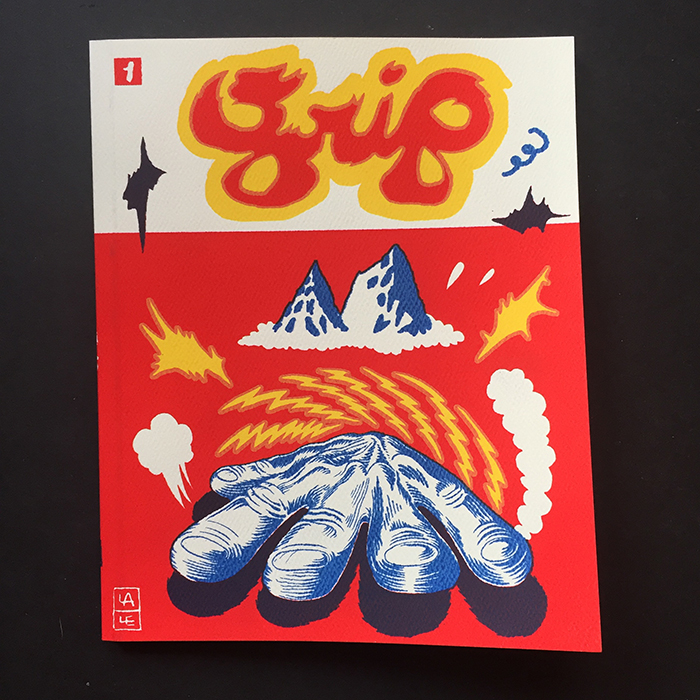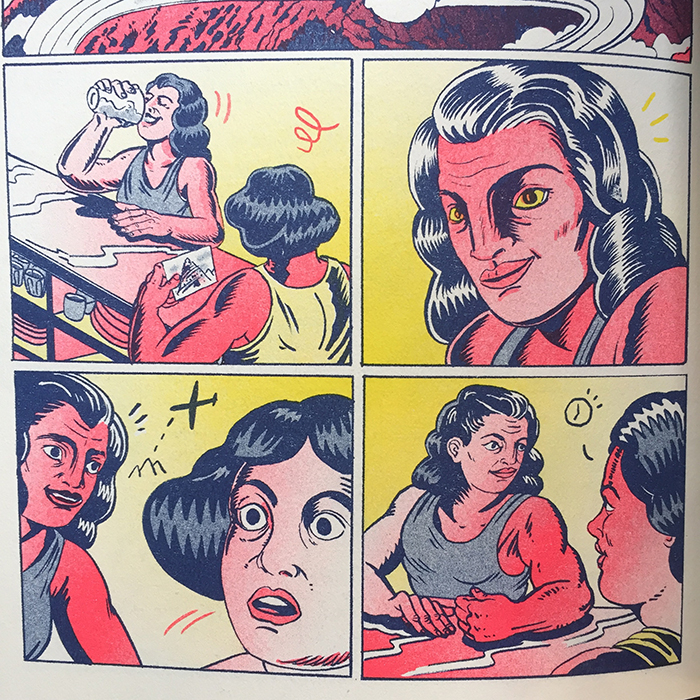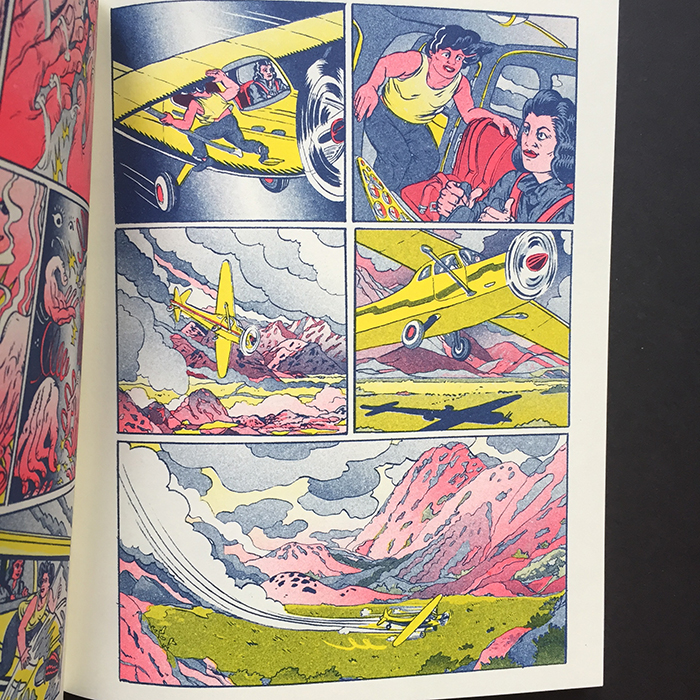Aaron CockleApril 2, 2018NewsAaron here today with Keren Katz; Mounira Al Solh; Yvan Alagbé; DRT; SOIMOCCA; Generative Adversarial Networks
—————————————————————————————————
Keren Katz on The Academic Hour
The 213th meeting of the NY Comics & Picture-story Symposium will be held on Tuesday, April 3, 2018 at 7pm at Parsons School of Design, Kellen Auditorium (Room N101, off the lobby), Sheila C. Johnson Design Center. 66 Fifth Avenue. Free and open to the public.
Keren will talk about the process of using dance, performance, props and costumes to generate the events that have inspired this book as well as her upcoming projects. She will demonstrate the techniques and references used to compose her pages and will also display a collection of contemporary Israeli Graphic Novels for viewing.
Keren Katz is a Tel Aviv based illustrator, comics artist and the non fictitious half of The Katz Sisters Duo. She graduated Bezalel Academy in Jerusalem, and received an MFA from The School of Visual Arts in NYC. She has contributed stories to anthologies published by Retrofit/Big Planet Comics, Locust Moon Comics, Smoke Signal, The Brooklyn Rail, Ink Brick Rough House Comics and more, as well as self publishing mini-comics all year round. She practices performative, interactive and collaborative storytelling marathons in odd locations, and is part of The Humdrum Comics Collective and Pathos Mathos Company. Her Ignatz nominated debut graphic novel is titled The Academic Hour (Secret Acres, 2017). https://www.instagram.com/thekatzsisters/
—————————————————————————————————
Mounira Al Solh: I strongly believe in our right to be frivolous
At Art Institute Chicago through April 29, 2018.
While the drawings map geographies of departure, arrival, and nonarrival through storytelling, the embroideries serve as testaments to more collective histories. Weaving together the accounts that connect and divide families, friends, and other relations across the spaces and temporalities of migration, these portraits made on fabric culminate in the Sperveri, a so-called bed-tent that memorializes recent events in the Middle East and Europe within a larger history of Islamic culture.
—————————————————————————————————
Shea Hennum at AV Club on Yvan Alagbé’s Yellow Negroes And Other Imaginary Creatures:
The story is told elliptically, with Alagbé shifting perspective, setting, and time period without warning or explicit notation. Dialogue and exposition are collapsed into one rhetorical space, and all the text is set off from the images. The effect is a distancing, and the eye is able to focus on and fall in love with Alagbé’s images, rich black smears of ink converging and diverging from one another in passionate plays of sex, sorrow, and salvation. But while there are no white figures in the story, there are allusions to white characters, demonstrating the inescapable gravitational well that is whiteness. “Dyaa” serves as the most aesthetically pure distillation of Alagbé’s ethos, because he makes literal what was merely figurative in “Yellow Negroes”: the idea that blackness is constituted by whiteness and vice versa—infinitely complicating the questions he introduced in that first vignette, “Love.”
—————————————————————————————————
Was it your intent for this book to have an air of mystery around it?
RJ Casey Interviews D.R.T.
The terms dodecahedrons and oblongs are used prominently in this comic and your backgrounds, even your endpapers, feature three-dimensional shapes. What is your interest in geometry?
I find geometric shapes aesthetically pleasing. Also, the mathematical meaning that is inherent to geometry is equally as pleasing to me. Math is responsible for the way our universe works, from quantum mechanics to something as simple as 2+2=4. It is a universal truth that if you have two things, and add them to two other things, you will have four things. Why is that so? And why does math work so well in our universe? In the universe that Qoberious takes place in, math has the same roll and these geometric shapes symbolize that. Every time I write a scene with the Keepers, I spend days researching different mathematical concepts and when I’m all done, I think this isn’t funny, and why am I trying to prove? I end up cutting it out.
—————————————————————————————————
Society of Illustrators Museum of Cartoon and Comic Art Arts Festival
The MoCCA Arts Festival is a 2-day multimedia event, Manhattan’s largest independent comics, cartoon and animation festival, drawing over 7,000 attendees each year. With 400 exhibiting artists displaying their work, award-winning honorees speaking about their careers and artistic processes and other featured artists conducting workshops, lectures and film screenings, our Festival mission accelerates the advancement of the Society’s broader mission to serve as Manhattan’s singular cultural institution promoting all genres of illustration through exhibitions, programs and art education.
The 2018 MoCCA Arts Festival will take place April 7-8th, 2018 at Metropolitan West in New York City with programming mere steps away at Ink48 (653 11th Ave).
Here are a couple panels of note:
3:30 pm / HELVETICA ROOM
The International Scene: Max de Radiguès and Anna Haifisch
Every comics culture — no matter how vast only presents and perceives a fragmentary view of global comics culture, a rich field of diverse human expression that is interconnected in some ways, and disconnected in others. International festivals and publishers can be sites for global exchange, and individual artists who travel and work outside of their home countries help develop ties between comics cultures. Max de Radiguès’s graphic novel about his time at the Center for Cartoon Studies was part of the Official Selection at the Festival International de la Bande Dessinée in Angoulême in 2012, and his second English-language translation is forthcoming from Conundrum Press. He is additionally the co-publisher of the Belgian publishing house Employ du moi. Anna Haifisch is internationally known for her comics series, The Artist, and has published widely in many languages. Her book Von Spatz was recently published by Drawn and Quarterly. They will discuss their work and the international comics scene with Bill Kartalopoulos.
2:00 pm / HELVETICA ROOM
Somatic Comics: Drawing the Body
Comics frequently render the body — in ways both realistic and abstract — and are typically indeces of the body, made by the hands of artists who labor at desks and tablets. Kriota Willberg’s work covers all aspects of this spectrum: her new book Draw Stronger offers medically-grounded self-care instruction for cartoonists engaged in the repetitive labor of comics-making, and her larger body of work includes drawing and needlework based on anatomical and other medical imagery. She will be joined in a discussion about comics, health, and images of the body by Kate Lacour (Vivisectionary) and Lauren Weinstein (Normel Person, “Carriers”), whose work has engaged and expressed ideas about anatomy and pathology in diverse and fascinating ways. Moderated by Marsha Hurst (Columbia University, Narrative Medicine).
—————————————————————————————————
“The way that it paints faces makes me uncomfortable. It always paints them as like, purple and yellow globs — that isn’t in the training set so I’m actually still not sure why it does that”
AI researcher Robbie Barrat decided to see what would happen when he fed a Generative Adversarial Network (GAN) thousands of nude portraits from a dataset and then trained it to create its own bizarre artworks.
Generative adversarial networks are defined as a class of artificial intelligence algorithms used in unsupervised machine learning, which uses two different neural networks, one called the “generator” and one the “discriminator.”
“The generator tries to come up with paintings that fool the discriminator, and the discriminator tries to learn how to tell the difference between real paintings from the dataset and fake paintings the generator feeds it,” Barrat told me. “They both get better and better at their jobs over time, so the longer the GAN is trained, the more realistic the outputs will be.”
Some additional GAN info can be found here.
To understand GANs, you should know how generative algorithms work, and for that, contrasting them with discriminative algorithms is instructive. Discriminative algorithms try to classify input data; that is, given the features of a data instance, they predict a label or category to which that data belongs.
—————————————————————————————————
Joanie and Jordie – 3-3-2018 – by Caleb Orecchio
Share this page: [...]




Looks bloody great!!!